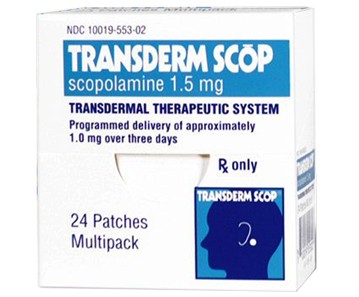
scopolamine – transdermal, Transderm-Scop
Medication Uses How To Use Side Effects Precautions Drug Interactions Overdose Notes Missed Dose Storage USES: This skin patch is used to prevent nausea and vomiting caused by motion sickness or recovery from anesthesia and surgery. It works by correcting the imbalance of natural substances that can occur in motion sickness. It also blocks certain signals to the brain that can cause nausea and vomiting. This medication is not recommended for use in children. HOW TO USE: Peel off the clear backing from the patch and apply it to the skin behind the ear. Press firmly for at least 30 seconds to ensure the patch sticks well. The patch will slowly release the medication into your body over 3 days. Do not use the patch if it is broken, cut, or damaged. If using the patch for motion sickness, apply it at least 4 hours before the activity. Replace the patch every 3 days. If using the patch after surgery, apply it the evening before. If the surgery is for a cesarean section, apply the patch 1 hour before the procedure. Remove and discard the patch as directed by your doctor, usually 24 hours after surgery. If the patch comes off or needs to be replaced, discard the old one and apply a new one behind the other ear. Wash your hands after handling the patch and wash the area behind the ear where the patch was removed. After stopping this medication, you may experience dizziness, loss of balance, nausea/vomiting, headache, muscle weakness, or slow heartbeat. If these effects occur, they usually appear 24 hours or more after stopping the medication. Report any such reactions to your doctor right away. Tell your doctor if your condition persists or worsens. SIDE EFFECTS: Blurred vision and widened pupils may occur as your body adjusts to the medication. Dry mouth, drowsiness, dizziness, decreased sweating, constipation, and mild itching/redness at the application site may also occur. If any of these effects persist or worsen, tell your doctor or pharmacist promptly. To relieve dry mouth, use sugarless hard candy or ice chips, chew sugarless gum, drink water, or use a saliva substitute. Remember that your doctor has prescribed this medication because the benefit to you is greater than the risk of side effects. Remove the patch and tell your doctor right away if you have any serious side effects, including: mental/mood changes, difficulty urinating, eye problems, fast/irregular heartbeat. A very serious allergic reaction to this drug is rare. However, get medical help right away if you notice any symptoms of a serious allergic reaction, including: rash, itching/swelling, severe dizziness, trouble breathing. This is not a complete list of possible side effects. If you notice other effects not listed above, contact your doctor or pharmacist. PRECAUTIONS: Before using scopolamine, inform your doctor or pharmacist if you are allergic to it or to other belladonna alkaloids, or if you have any other allergies. This product may contain inactive ingredients that can cause allergic reactions or other problems. Talk to your pharmacist for more details. Before using this medication, tell your doctor or pharmacist your medical history, especially of: breathing problems, high pressure in the eye, heart disease, high blood pressure, seizures, stomach/intestine/esophagus problems, overactive thyroid, difficulty urinating, mental/mood disorders, kidney disease, liver disease, myasthenia gravis, uncontrolled pain. This drug may make you dizzy or drowsy or cause blurred vision. Do not drive, use machinery, participate in underwater activities, or do any activity that requires alertness or clear vision until you are sure you can perform such activities safely. Avoid alcoholic beverages. Before having surgery, tell your doctor or dentist about all the products you use. If you are going to have an MRI test, tell testing personnel that you are using this patch. Some patches may contain metals that can cause burns during an MRI. Ask your doctor whether you will need to remove your patch before the test and apply a new patch afterward, and how to do so properly. This medication may decrease your ability to sweat, making you more likely to get heat stroke. Avoid activities that may cause you to overheat. Watch for symptoms of overheating and seek medical help if necessary. Older adults may be more sensitive to the side effects of this drug, especially dizziness and drowsiness. During pregnancy, this medication should be used only when clearly needed. Discuss the risks and benefits with your doctor. This medication passes into breast milk. Consult your doctor before breast-feeding. DRUG INTERACTIONS: Drug interactions may change how your medications work or increase your risk for serious side effects. Keep a list of all the products you use and share it with your doctor and pharmacist. Do not start, stop, or change the dosage of any medicines without your doctor’s approval. Tell your doctor or pharmacist if you are taking other products that cause drowsiness. Check the labels on all your medicines because they may contain ingredients that cause drowsiness. This medication may interfere with certain laboratory tests. Make sure laboratory personnel and all your doctors know you use this drug.
QUESTION
OVERDOSE: This medication patch may be harmful if chewed or swallowed. If overdose or swallowing is suspected, remove the patch if possible, and contact a poison control center or emergency room immediately. Symptoms of overdose may include: severe drowsiness, mental/mood changes, fast/irregular heartbeat, seizures, hot/dry skin. NOTES: Do not share this medication with others. MISSED DOSE: If you forget to replace a patch at the scheduled time, replace it as soon as you remember. Do not use more than one patch at a time. STORAGE: Store at room temperature. Do not store in the bathroom. Keep all medications away from children and pets. Do not flush medications down the toilet or pour them into a drain unless instructed to do so. Properly discard this product when it is expired or no longer needed. Consult your pharmacist or local waste disposal company. Information last revised March 2013. Copyright(c) 2013 First Databank, Inc.
Report Problems to the Food and Drug Administration
You are encouraged to report negative side effects of prescription drugs to the FDA. Visit the FDA MedWatch website or call 1-800-FDA-1088.
Selected from data included with permission and copyrighted by First Databank, Inc. This copyrighted material has been downloaded from a licensed data provider and is not for distribution, except as may be authorized by the applicable terms of use.
CONDITIONS OF USE: The information in this database is intended to supplement the expertise and judgment of healthcare professionals. It is not intended to cover all possible uses, directions, precautions, drug interactions, adverse effects, or to indicate that the use of a particular drug is safe, appropriate or effective for you or anyone else. A healthcare professional should be consulted before taking any drug, changing any diet or commencing or discontinuing any course of treatment.


